You know Volvo: The safety company, the sustainability company, the company that makes gorgeous crossovers and wagons for whisking young urban professionals to their business meetings and Vermont ski trips. Driving the new EX30 through Swedish city streets, I thought I knew Volvo too — but I’d forgotten another side to the Swedes.
I’d forgotten Volvo’s endeavors in touring car racing, the company’s years of turbos and manual transmissions. I’d forgotten that Volvo makes cars that slide, and that compact electric crossovers can feel like hatchbacks when they’re out on the road. I had forgotten that plain-jane commuter cars can still be a blast when hucked around. But Volvo, it seems, didn’t forget at all.
Full Disclosure: Volvo flew me out to Sweden to test drive the new EX30 on city streets, snowy back roads, and a track built on a frozen lake. I managed to neither plow through the snowbanks nor fall through the ice, which I’m counting as a win. The company paid for my airfare, lodging, and food, a surprising amount of which was reindeer-based.
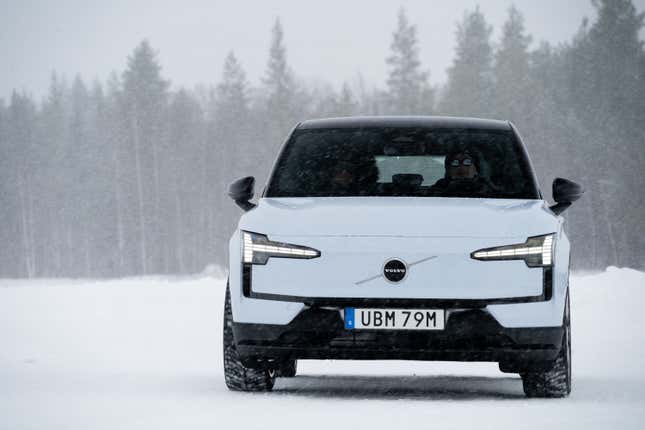
What Are The Specs?
First thing’s first: The Volvo EX30 is smaller than you think. No, even smaller than that. Just 166.7 inches from tip to tail, this crossover is over an inch shorter than a Toyota GR86. It’s 72.3 inches wide, 61.2 inches tall, and carries its weight seven inches from the ground. Don’t picture an Ioniq 5 for scale, don’t even picture a Kia Niro — the EX30 is a 4:3 GTI.
Not that the GTI can really compare for power or torque, of course. Even the base rear-wheel-drive EX30 claims 268 horsepower and 253 pound-feet of torque, while the high-performance dual-motor all-wheel-drive trim bumps those numbers to 422 hp and 400 lb-ft respectively, good for a 3.4-second sprint to 60, down from the base car’s 5.1 seconds. Weight specs have yet to be revealed for the U.S. market, but Volvo does claim that the car’s 69-kWh battery pack is good for 275 miles of range in the single-motor variant.

Is It A Crossover Or A Hatchback?
This was a subject of much debate within the trip. After all, the EX30 isn’t even as long as a GTI – sure, it’s taller, but is it really tall enough to warrant crossover status? It’s not even as tall as a Honda HR-V.
My vote says it’s a crossover. When stepping in, the seat is very close to my standing hip height, like you’d find in a Scion xB. If you don’t need to sit down into a car, the exterior dimensions matter less. The EX30 is going to feel like a crossover from the driver’s seat, and that’s what matters when you’re actually buying a car.

So Is The EX30 A Rally Car?
Given the whole “frozen lake track drive” aspect of this trip — which began with an instructor making sure we all knew the basics of a Scandinavian Flick, to kick the rear of the car out on ice — you might think the EX30 is some secret rally monster. After all, it’s got all that horsepower and torque, surely it’s a Renault 5 Turbo on stilts. Well, sorry to burst your bubble, but not exactly.
Even the base RWD trim has more than enough power to kick the back end loose, especially on snow or ice. (As a former Scion FR-S owner, I can confirm that you don’t really need much.) The more powerful AWD model slides even better, but the difference isn’t actually due to that second motor. Instead, it all comes down to software.
See, despite the presence of an “ESC Off” toggle in the car’s center screen, it doesn’t actually turn the stability and traction control fully off. It’ll let you slide, but only a little — the computer is quick to reel you back in just when you’re getting to the fun part. Oddly, the traction control is far more restrictive in the rear-drive car, where slides are far harder to manage while combating the computer’s attempts to interfere.
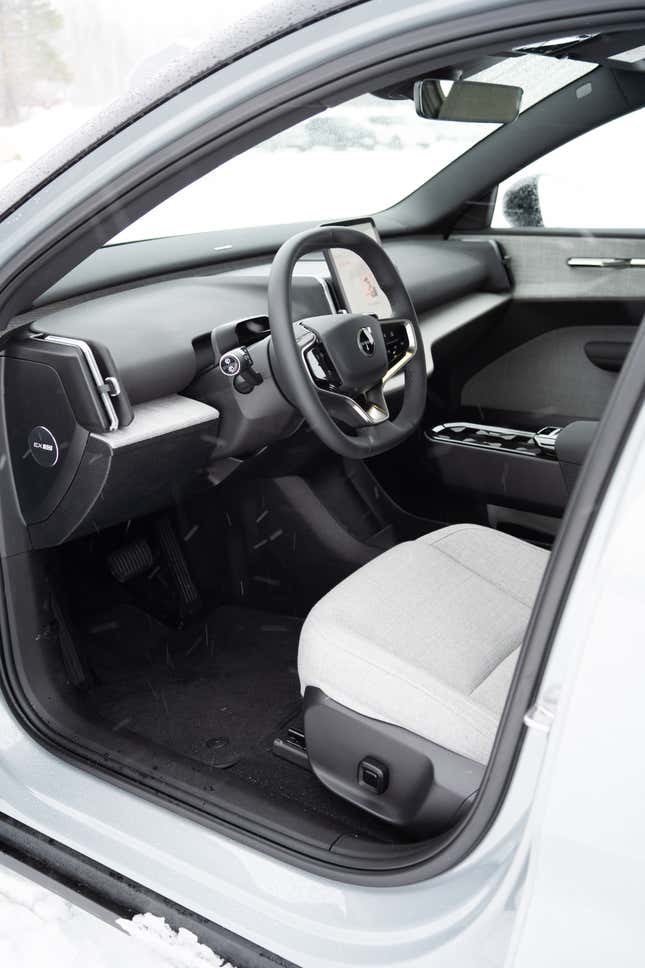
How’s The Interior?
It’s just what you’d expect from a $35,000 Volvo. The layout is minimal and clean, the touchpoints are nice under your fingertips, and everything almost makes sense. The seats are, somehow, some of the most comfortable I’ve found from the brand’s lineup, and the whole cabin is quiet even on studded snow tires. The steering wheel shape isn’t my favorite — the wheel narrows toward the bottom, so placing your hands at nine and three forces my elbows into my ribs —– but the inside of the EX30 is still a nice place to be.
My tester was equipped with the optional Harmon Kardon stereo, which isn’t the strongest entry in this price point (the benchmark is, of all things, the Civic Si) but is more than passable for regular listening. The low-mids are a bit boomy, the overall sound a bit muddy, but Volvo’s EQ options are more in-depth than most. Spend enough time fine-tuning them, and you’ll likely find a sound that you’re happy with, even if you won’t be using it to master albums.
The arrangement of the EX30’s physical controls will make sense to an owner after about a week in the car, but before that, there’s a learning curve. The buttons on the steering wheel are multipurpose, changing based on what the center screen is doing, and they’re oddly specific in where they want to be pressed. The wiper stalks take some getting used to, and the column shifter also activates the driver assist features. Everything is condensed together, mainly, of course, into that big center screen.
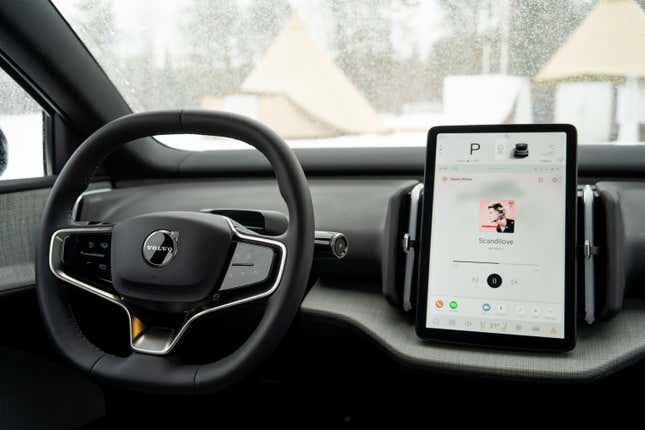
Oh It’s All In The Center Screen, Huh?
Noticed that in the pictures, did you? The lack of any kind of gauge cluster in front of the steering wheel? Those who saw an expanse of black plastic and optimistically hoped it might be a screen that just didn’t photograph right are forgiven, but that appears to be an eye-tracking sensor to ensure your attention stays on the road — a sensor that sees more than its fair share of work, given that many controls are buried three screens deep on the display.
Want to adjust your mirrors to see the curb while you’re parallel parking? Look over to the center display, open the settings page, hit the mirror button, choose which mirror you’d like to change, and only then can you look up and start using the steering wheel buttons to re-angle the glass. By this point, you’ll have a notification in the top right corner of the screen telling you to keep your eyes on the road, but how can you?
Stability control, the performance mode, and steering weight are even further buried. God help you if you want to pull up a specific song from the car’s built-in Spotify app while on the go — the Google-based operating system requires you to take your eyes off the road as the keyboard requests permission to open the microphone. This issue, by the way, appears on the EC40 as well. It’s just how this OS works.
Watching your speed on the top corner of the center screen isn’t the end of the world, but it feels more distracting than just having a screen ahead of you. Even a head-up display, printed on the windshield, would feel more in line with Volvo’s commitment to safety — a commitment that includes pushing back on distracted driving. But HUDs aren’t free, and the EX30 is the cheapest vehicle within Volvo’s lineup.
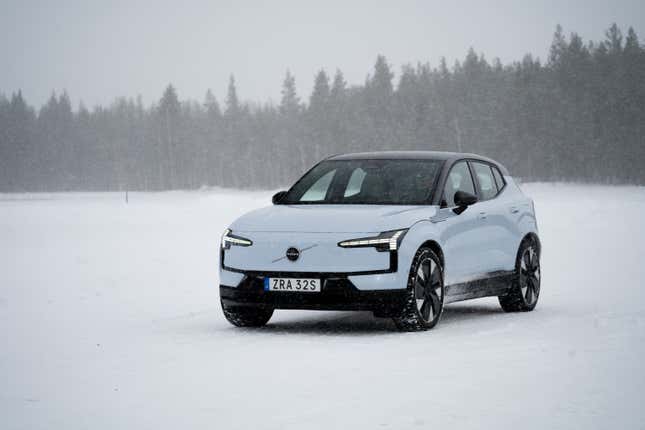
So That’s How They Got It Down To $35,000?
Every little bit counts, right? Despite the quality of the design and many of the touchpoints, you can still feel the budget in the EX30. The plastic that makes up the hideable cup holders isn’t the most solid, and the car only has two console-mounted window switches — you’ll have to toggle between using them for the front and rear doors, like on a Volkswagen ID.4.
Volvo didn’t deck the EX30 out in hard plastics all over, keeping in line with their stated goal of “big car energy.” The company hopes that buyers will want a compact, easy-to-city-park car for a decent price that doesn’t feel like a penalty box from the inside. For the target markets of pre-kid couples and aging empty nesters, who both have budgets on their minds, it’s likely a safe play.
The EX30 compromises on window switches, a gauge cluster, and some of the more fidelity-enhancing aspects of the stereo. In exchange, it sticks to the $35,000 price point without sacrificing a well-tuned suspension, a quiet cabin, or nice materials on the parts of the car you’ll actually touch.
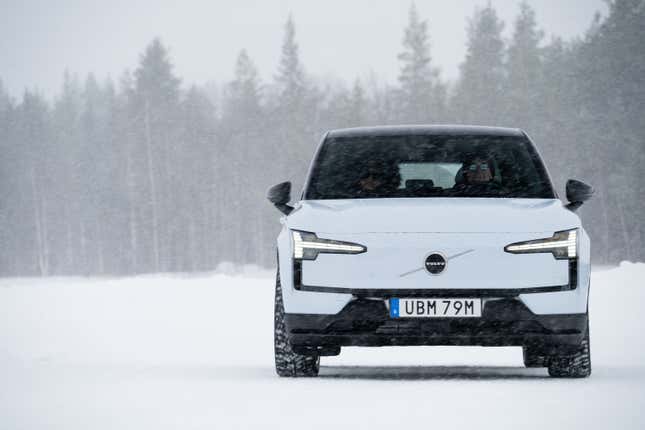
What’s The Verdict?
The Volvo EX30 is a fantastic car for this period of the EV transition. It’s attainably priced, feature-rich, and has enough range or performance to ease ICE owners into the world of electrification — and, in Volvo’s hopes, onboard buyers to a brand they’ll keep buying.
Even considering its price, though, the car isn’t perfect. Its one-pedal driving mode has weak regenerative braking, and the Pilot Assist suite of driver-assist features took some real experimentation to figure out. Addressing these wouldn’t add cost to the car — they don’t require extra buttons or new computers — but they’d go a long way towards making the EX30 feel even further above its price point.
In all, the Volvo EX30 is a hell of a lot of EV for $35,000. In our world of $50,000 average transaction prices, this technically constitutes a “cheap car,” yet it’s so far from the plasticky, rattly bargain-basement cars we’re used to. It’s sleek, beautiful, comfortable, and entertaining to drive, even without breaking traction.


